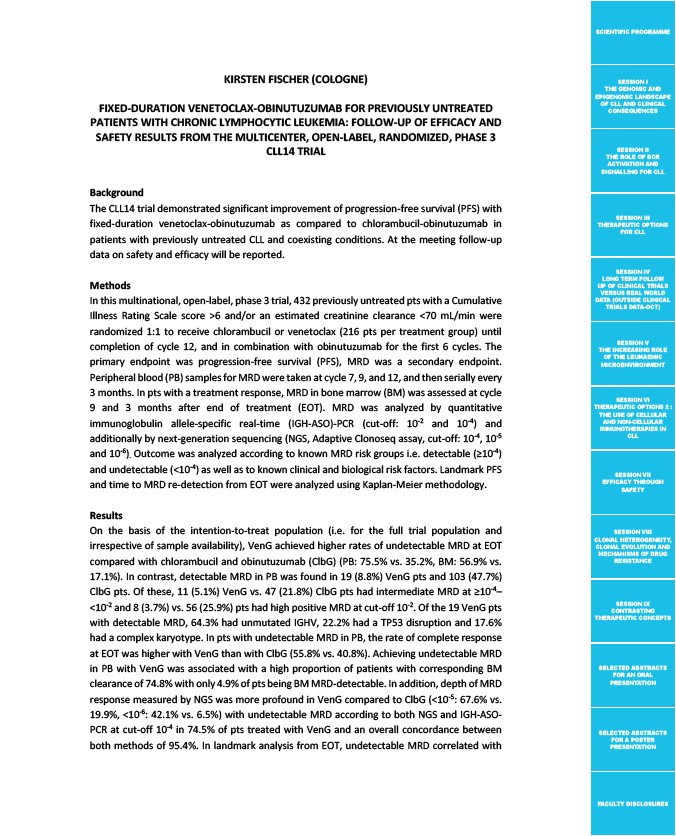
SCIENTIFIC PROGRAMME
SESSION I
THE GENOMIC AND
EPIGENOMIC LANDSCAPE
OF CLL AND CLINICAL
CONSEQUENCES
SESSION II
THE ROLE OF BCR
ACTIVATION AND
SIGNALLING FOR CLL
SESSION III
THERAPEUTIC OPTIONS
FOR CLL
SESSION IV
LONG TERM FOLLOW
UP OF CLINICAL TRIALS
VERSUS REAL WORLD
DATA (OUTSIDE CLINICAL
TRIALS DATA-OCT)
SESSION V
THE INCREASING ROLE
OF THE LEUKAEMIC
MICROENVIRONMENT
SESSION VI
THERAPEUTIC OPTIONS 2 :
THE USE OF CELLULAR
AND NON-CELLULAR
IMMUNOTHERAPIES IN
CLL
SESSION VII
EFFICACY THROUGH
SAFETY
SESSION VIII
CLONAL HETEROGENEITY,
CLONAL EVOLUTION AND
MECHANISMS OF DRUG
RESISTANCE
SESSION IX
CONTRASTING
THERAPEUTIC CONCEPTS
SELECTED ABSTRACTS
FOR AN ORAL
PRESENTATION
SELECTED ABSTRACTS
FOR A POSTER
PRESENTATION
FACULTY DISCLOSURES
KIRSTEN FISCHER (COLOGNE)
FIXED-DURATION VENETOCLAX-OBINUTUZUMAB FOR PREVIOUSLY UNTREATED
PATIENTS WITH CHRONIC LYMPHOCYTIC LEUKEMIA: FOLLOW-UP OF EFFICACY AND
SAFETY RESULTS FROM THE MULTICENTER, OPEN-LABEL, RANDOMIZED, PHASE 3
CLL14 TRIAL
Background
The CLL14 trial demonstrated significant improvement of progression-free survival (PFS) with
fixed-duration venetoclax-obinutuzumab as compared to chlorambucil-obinutuzumab in
patients with previously untreated CLL and coexisting conditions. At the meeting follow-up
data on safety and efficacy will be reported.
Methods
In this multinational, open-label, phase 3 trial, 432 previously untreated pts with a Cumulative
Illness Rating Scale score >6 and/or an estimated creatinine clearance <70 mL/min were
randomized 1:1 to receive chlorambucil or venetoclax (216 pts per treatment group) until
completion of cycle 12, and in combination with obinutuzumab for the first 6 cycles. The
primary endpoint was progression-free survival (PFS), MRD was a secondary endpoint.
Peripheral blood (PB) samples for MRD were taken at cycle 7, 9, and 12, and then serially every
3 months. In pts with a treatment response, MRD in bone marrow (BM) was assessed at cycle
9 and 3 months after end of treatment (EOT). MRD was analyzed by quantitative
immunoglobulin allele-specific real-time (IGH-ASO)-PCR (cut-off: 10-2 and 10-4) and
additionally by next-generation sequencing (NGS, Adaptive Clonoseq assay, cut-off: 10-4, 10-5
and 10-6). Outcome was analyzed according to known MRD risk groups i.e. detectable (≥10-4)
and undetectable (<10-4) as well as to known clinical and biological risk factors. Landmark PFS
and time to MRD re-detection from EOT were analyzed using Kaplan-Meier methodology.
Results
On the basis of the intention-to-treat population (i.e. for the full trial population and
irrespective of sample availability), VenG achieved higher rates of undetectable MRD at EOT
compared with chlorambucil and obinutuzumab (ClbG) (PB: 75.5% vs. 35.2%, BM: 56.9% vs.
17.1%). In contrast, detectable MRD in PB was found in 19 (8.8%) VenG pts and 103 (47.7%)
ClbG pts. Of these, 11 (5.1%) VenG vs. 47 (21.8%) ClbG pts had intermediate MRD at ≥10-4–
<10-2 and 8 (3.7%) vs. 56 (25.9%) pts had high positive MRD at cut-off 10-2. Of the 19 VenG pts
with detectable MRD, 64.3% had unmutated IGHV, 22.2% had a TP53 disruption and 17.6%
had a complex karyotype. In pts with undetectable MRD in PB, the rate of complete response
at EOT was higher with VenG than with ClbG (55.8% vs. 40.8%). Achieving undetectable MRD
in PB with VenG was associated with a high proportion of patients with corresponding BM
clearance of 74.8% with only 4.9% of pts being BM MRD-detectable. In addition, depth of MRD
response measured by NGS was more profound in VenG compared to ClbG (<10-5: 67.6% vs.
19.9%, <10-6: 42.1% vs. 6.5%) with undetectable MRD according to both NGS and IGH-ASO-PCR
at cut-off 10-4 in 74.5% of pts treated with VenG and an overall concordance between
both methods of 95.4%. In landmark analysis from EOT, undetectable MRD correlated with